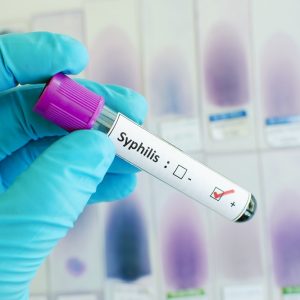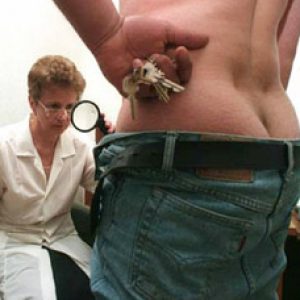Syphilis is an infectious venereal disease caused by spirochete Treponema pallidum. Transmission: during sex, from mother to fetus, transfusion, and much less commonly, through wounds on the skin that come into contact with infectious lesions. Depending on the stage, isolated, primary, secondary, latent and tertiary syphilis.
Microscopy in a dark field
Treponema pallidum cannot grow on nutrient media and is not visualized under light microscope. As pathogen detection by conventional microscopy cannot use a microscope with a dark field, where the pathogen is visible in the form of a spiral on a dark background.
To conduct microscopy, the biomaterial is taken from the suspected lesion. Microscopy in a dark field is a possible way of evaluating cutaneous lesions, such as chancre of primary syphilis or the condyloma of secondary syphilis. If the material maculopapular lesion is dry, examine the aspirate of the lymph node.

A negative result does not exclude the pathological process, the statistical identification of the pathogen is possible only in 80%.
PCR diagnostics
Reaction is directed to a manifold increase in DNA Treponema pallidum, allows to make a conclusion about infection with syphilis or lack thereof.

The biological material for analysis may be any of: blood, the contents of sifilide, cerebrospinal fluid, etc. Test is suitable for the incubation period.
PCR is fully specific.
Indirect serological tests for syphilis: treponemal and non-treponemal tests
Serological tests (CEB or the complex of serological reactions) are considered the most common method for the diagnosis of all stages of syphilis.
There are the following reactions:
- agglutination;
- of precipitation;
- immunofluorescence;
- enzyme-linked immunosorbent assay, etc.
Also serological tests for syphilis are divided into treponemal and non-treponemal.
Non-treponemal
In case of suspected acquired syphilis, perform a screening test, which is used non-treponemal teststo determine antibodies to lipid antigens of host tissues or pathogen in a variety of modifications. In Russia routinely performed by reaction of microprecipitation (RMP), which allows to detect antibodies to the pathogen-damaged cells in the blood. The accuracy of screening is high but the specificity is small, so the test is suitable for primary screening for preventive purposes.
The sensitivity of the rapid tests evaluated in 78-86% for detecting primary syphilis, 100% for secondary syphilis, and 95-98% for detecting tertiary syphilis.
The specificity of from 85-99%, sometimes less than that found under the following conditions:
- gestation;
- menstruation;
- Oncology;
- connective tissue disease;
- tuberculosis;
- malaria;
- viral disease;
- liver disease;
- vaccination;
- “fresh” to THEM;
- typhus, etc.
In addition, excess fat in the diet, drinking alcohol beverages and taking certain medications can lead to monologically conclusions.
The results of the screening test turn positive 1-2 weeks after chancre formation. Non-treponemal tests give a negative answer after some time after treatment. When the HIV status of non-treponemal antibodies can be detected for a long time, sometimes throughout life (as evidenced by the results of the corresponding randomizeorder research).
Other types of non-treponemal tests: VDRL, plasmatreeview test (RPR), a test by toluidine red, complement fixation with cardiolipin antigen (RSCC).
Wasserman (RW)
The binding of complement – immune system’s response to infection, the result varies from negative (put “-“), to strongly positive “++++” or 4 plus.
In the initial stage of primary syphilis RW negative.
Treponemal
Because of the possibility of false positive results to confirm any positive or doubtful result non-treponemal analysis used treponemal tests:
- the reaction immunofluorescence (RIF);
- hemagglutinate (TPPA),
- enzyme-linked immunosorbent assay (ELISA) for immunoglobulin G (IgG) and immunoglobulin M (IgM);
- Western blot sections;
- RIBT/RIT (reaction immobilization pale treponemes).
Treponemal tests are used to assess the effectiveness of therapy.
The REEF on the definition at the treponemal IgG class is used after a positive result of the rapid tests (sensitivity 84% in primary syphilis and 100 % in other stages, specificity 96%). For the diagnosis of congenital syphilis in newborns is not applicable.
Some laboratories use a “reverse” screening tests.
CDC (Centers for Disease Control and Prevention, USA) recommends traditional studies, with verification of quantitative non-treponemal tests with a positive result of the treatment.
The reaction immunofluorescence (RIF)
Assembled material is applied the serum with fluorochrome labeled antibodies specific to the antigen of Treponema pallidum, the causative agent attracts immune complexes, which begins to glow in a fluorescent microscope.
The reaction of the passive hemagglutination or TPPA
Before the advent of hemagglutination (bonding) of erythrocytes since the introduction of Treponema pallidum must be at least 4 weeks.
The prepared red blood cells with fixed protein fractions pathogen to interact with the plasma, if there are antibodies to the syphilis reaction occurs.
Suitable for confirmation of any stage of the disease.
Enzyme-linked immunosorbent assay
It is based on the reaction antigen-antibody. Identify antibodies of different classes, which can be quantified.
The obtained results allow to judge about the duration of the pathological process, success of the treatment, immunological status, activity of pathogens.
Western blot sections – variation of ELISA used for in-depth diagnosis in all doubtful results.
The sensitivity and specificity close to 100%, today ultrafunktsionalnuyu method of identifying proteins.
RIBT
The method is based on the reaction antigen-antibody. Serve as the antigen Treponema pallidum cultivated in rabbit testes. When interacting with the antibodies of an infected person, the pathogens lose their mobility. The reaction is evaluated using microscopy in a dark field.
RIBT currently used because of the complexity less, but the analysis can be useful for solving contentious issues (false positive reaction for syphilis).
Differential diagnosis of
The greatest challenge is the diagnosis of tertiary syphilis that is caused by symptoms of the cardiovascular and nervous systems, as well as a manifestation from the skin.
Patients must be screened for gonorrhea, trichomoniasis, chlamydiosis, bacterial vaginosis, HIV infection and hepatitis b and C.
List the diseases that conduct the differential diagnostics in syphilis:
What begins diagnosis of syphilis
Initially interviewed with the patient, in which are specified the details: when were suspicious sexual contact and what are the complaints.

After collecting anamnesis transferred to physicalname examination, special attention is paid to the genital area and anus, mucous membranes and lymph nodes. A preliminary diagnosis may already be installed. Final verification occurs through laboratory tests.
If to say simply about complicated things, then some tests to identify the causative agent of syphilis, and others reflect the body’s reaction to the introduction of pale Treponema.
To install the final diagnosis TPPA should complement 1 1 treponemal and non-treponemal assay.
Diagnosis of syphilis in pregnancy
There are compulsory study for syphilis multiple times during pregnancy.
Focus on the analysis of CEB is given during the first visit women in counseling, and during pregnancy performed three times a survey. Patients from high risk groups with a complicated history: STIs, antisocial, dependent, etc. require particularly close attention.
If the test results are positive, conduct a deeper diagnosis, and according to the testimony prescribe a treatment that depends on the stage and clinical manifestations.
Diagnosis of congenital syphilis
Most children with congenital syphilis born to untreated mothers or who received the therapy too late.

Treponemal tests using neonatal serum is not recommended due to passive transfer of IgG antibodies. All children born to mothers with syphilis should be tested with a quantitative non-treponemal serologic test (RPR or VDRL) performed using the serum of the newborn.
How to interpret the results of serological studies
The reaction of microprecipitation, REEF and TPPA negative norm, positive confirmation of syphilis.
The reaction of microprecipitation negative, the other positive – syphilis in anamnesis after carrying out specific treatment or late stage.
Negative REEF with a positive TPPA and the reaction of microprecipitation – the result is in doubt, the comprehensive re-assessment.
A negative result of RIF and microprecipitation, but a positive TPPA – state after successful antibiotic treatment or a false positive result.
RIF positive with negative TPPA and the reaction of microprecipitation early stage, the treatment or uncertainty of the result.
The positive reaction of microprecipitation, not confirmed by any TPPA or RIF – lack of syphilis.
Instrumental examination in syphilis
Diagnostics is carried out depending on involvement of organs. For example, granulomatous liver disease can be seen with computed tomography of the abdomen.
Radiography of the chest in patients with tertiary syphilis may show dilation of the aorta. Linear calcification along the course of the aorta evidence in favor of the syphilitic aorta.
Angiography may be useful in the diagnosis of syphilitic abdominal aneurysm.
In the diagnosis of neurosyphilis when the appropriate symptoms are used lumbar puncture with a fence of cerebrospinal fluid.



